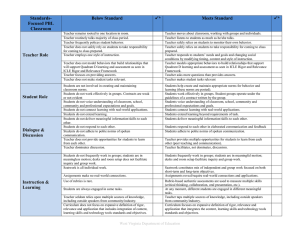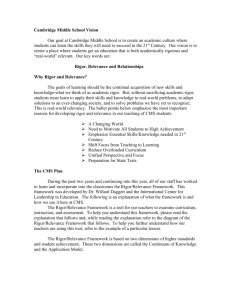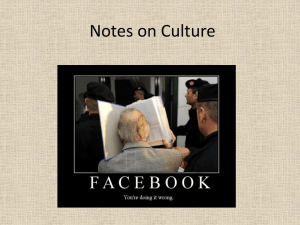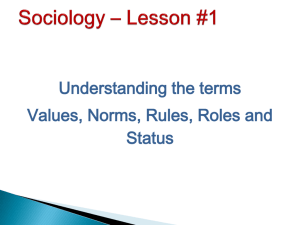Standards-Focused Below Standard Meets Standard *
advertisement
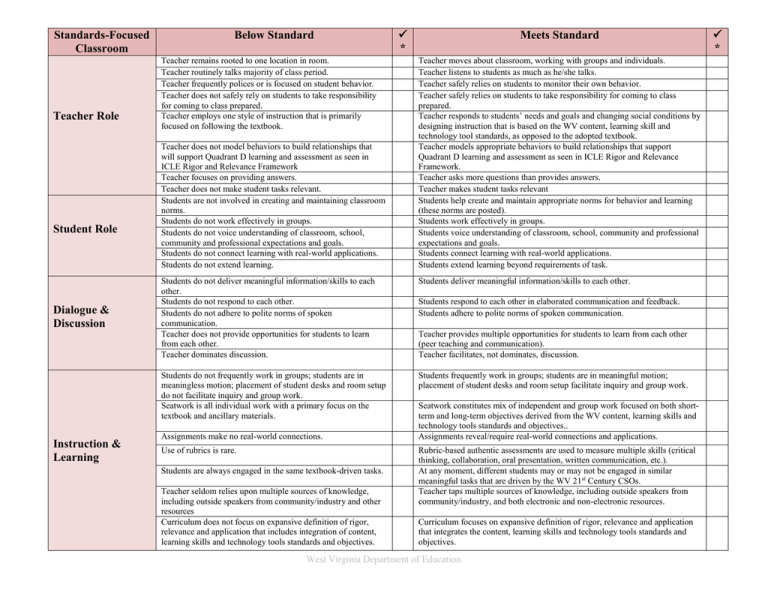
Standards-Focused Classroom Teacher Role Student Role Dialogue & Discussion Instruction & Learning Below Standard Teacher remains rooted to one location in room. Teacher routinely talks majority of class period. Teacher frequently polices or is focused on student behavior. Teacher does not safely rely on students to take responsibility for coming to class prepared. Teacher employs one style of instruction that is primarily focused on following the textbook. Teacher does not model behaviors to build relationships that will support Quadrant D learning and assessment as seen in ICLE Rigor and Relevance Framework Teacher focuses on providing answers. Teacher does not make student tasks relevant. Students are not involved in creating and maintaining classroom norms. Students do not work effectively in groups. Students do not voice understanding of classroom, school, community and professional expectations and goals. Students do not connect learning with real-world applications. Students do not extend learning. * Meets Standard Teacher moves about classroom, working with groups and individuals. Teacher listens to students as much as he/she talks. Teacher safely relies on students to monitor their own behavior. Teacher safely relies on students to take responsibility for coming to class prepared. Teacher responds to students’ needs and goals and changing social conditions by designing instruction that is based on the WV content, learning skill and technology tool standards, as opposed to the adopted textbook. Teacher models appropriate behaviors to build relationships that support Quadrant D learning and assessment as seen in ICLE Rigor and Relevance Framework. Teacher asks more questions than provides answers. Teacher makes student tasks relevant Students help create and maintain appropriate norms for behavior and learning (these norms are posted). Students work effectively in groups. Students voice understanding of classroom, school, community and professional expectations and goals. Students connect learning with real-world applications. Students extend learning beyond requirements of task. Students do not deliver meaningful information/skills to each other. Students do not respond to each other. Students do not adhere to polite norms of spoken communication. Teacher does not provide opportunities for students to learn from each other. Teacher dominates discussion. Students deliver meaningful information/skills to each other. Students do not frequently work in groups; students are in meaningless motion; placement of student desks and room setup do not facilitate inquiry and group work. Seatwork is all individual work with a primary focus on the textbook and ancillary materials. Students frequently work in groups; students are in meaningful motion; placement of student desks and room setup facilitate inquiry and group work. Assignments make no real-world connections. Use of rubrics is rare. Students are always engaged in the same textbook-driven tasks. Teacher seldom relies upon multiple sources of knowledge, including outside speakers from community/industry and other resources Curriculum does not focus on expansive definition of rigor, relevance and application that includes integration of content, learning skills and technology tools standards and objectives. Students respond to each other in elaborated communication and feedback. Students adhere to polite norms of spoken communication. Teacher provides multiple opportunities for students to learn from each other (peer teaching and communication). Teacher facilitates, not dominates, discussion. Seatwork constitutes mix of independent and group work focused on both shortterm and long-term objectives derived from the WV content, learning skills and technology tools standards and objectives.. Assignments reveal/require real-world connections and applications. Rubric-based authentic assessments are used to measure multiple skills (critical thinking, collaboration, oral presentation, written communication, etc.). At any moment, different students may or may not be engaged in similar meaningful tasks that are driven by the WV 21st Century CSOs. Teacher taps multiple sources of knowledge, including outside speakers from community/industry, and both electronic and non-electronic resources. Curriculum focuses on expansive definition of rigor, relevance and application that integrates the content, learning skills and technology tools standards and objectives. West Virginia Department of Education * West Virginia Department of Education
